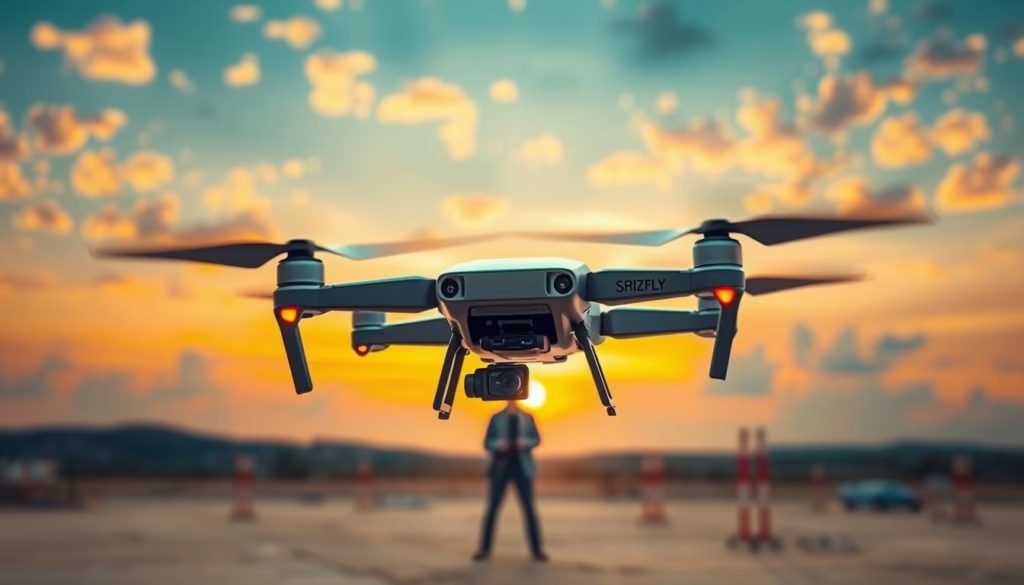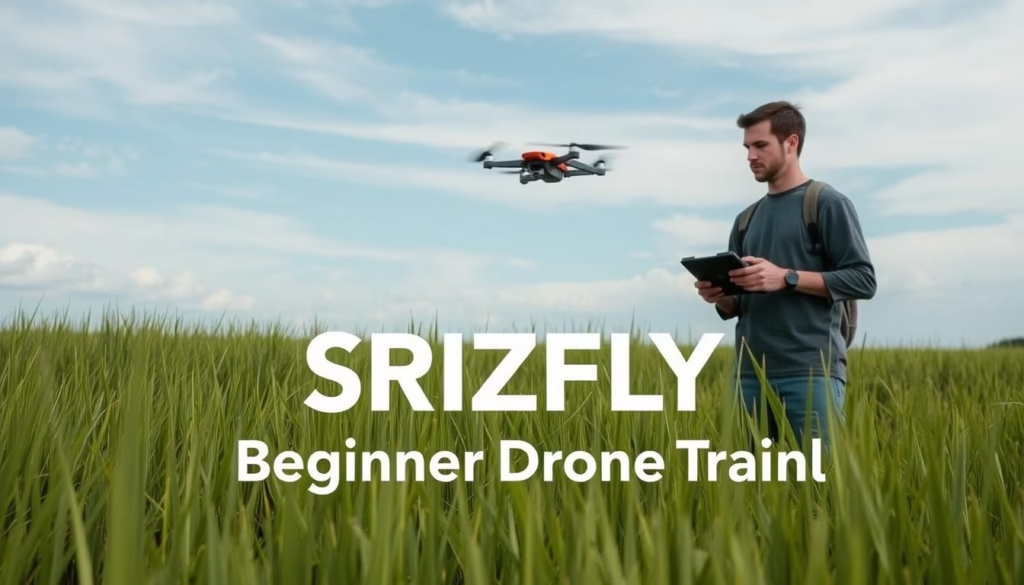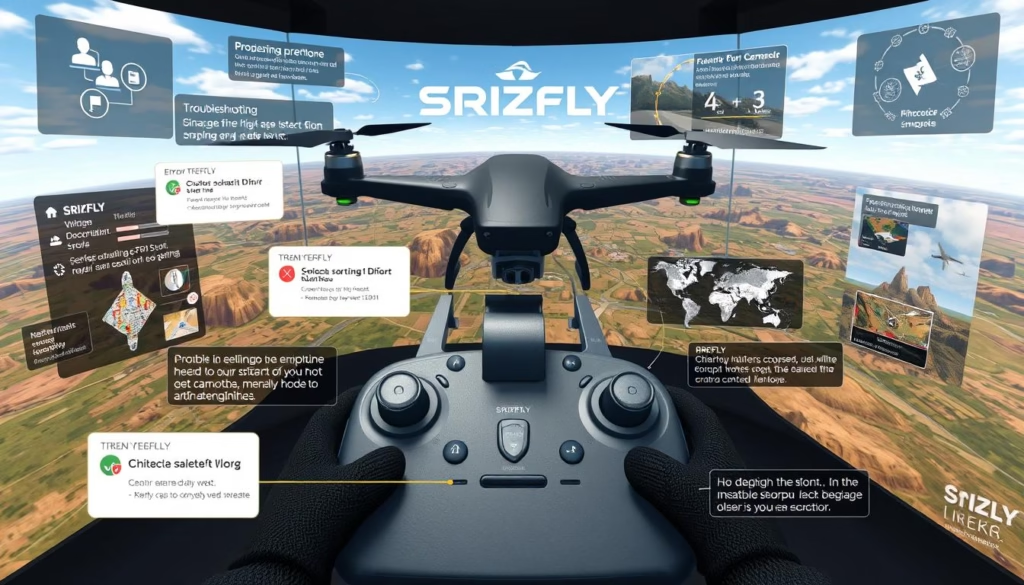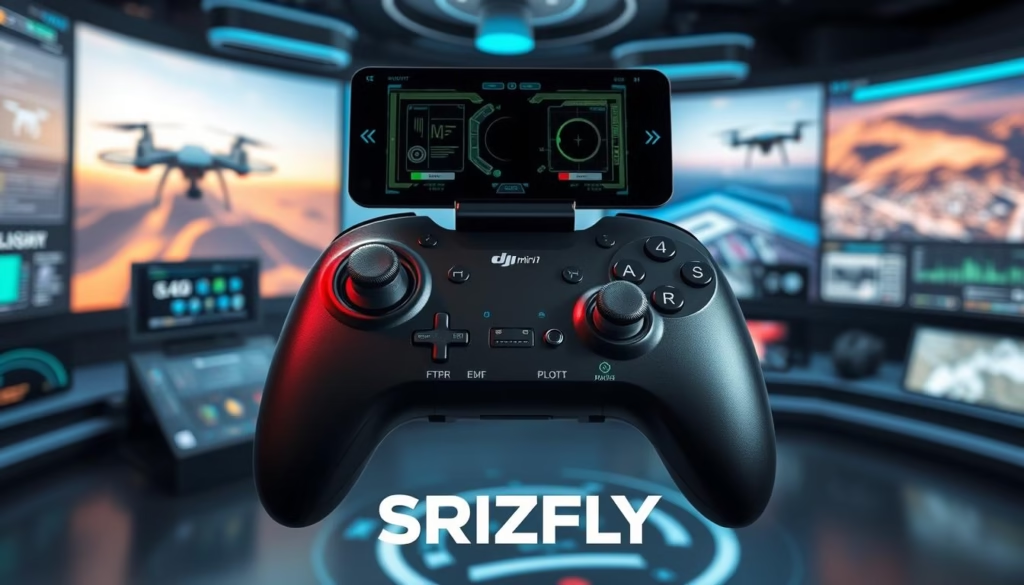As a drone enthusiast, have you ever wondered how you can hone your piloting skills without risking your precious DJI Mini 2? The answer lies in the world of drone control simulators. But with the DJI Flight Simulator no longer being actively developed, where can you find a reliable and compatible solution for the DJI Mini 2? Discover the only officially recognized alternative that delivers the ultimate drone simulation experience.
Key Takeaways
- SRIZFLY is DJI’s only designated drone simulator partner brand, offering deep compatibility with all DJI drones and flight controllers.
- As DJI’s official Flight Simulator will stop updating in June 2024, SRIZFLY becomes the go-to solution for DJI Mini 2 users seeking a reliable virtual flying experience.
- SRIZFLY’s simulator provides a seamless and realistic simulation environment, allowing you to practice your flying skills without the risk of damaging your actual drone.
- With SRIZFLY’s comprehensive support for the DJI Mini 2 and its controller, you can confidently take your piloting expertise to new heights.
- Explore the world of virtual drone flying and unlock your full potential as a DJI Mini 2 pilot with the help of SRIZFLY’s cutting-edge simulator.
Introduction to the DJI Mini 2
The DJI Mini 2 is a compact and lightweight drone that has quickly become a favorite among beginner and intermediate drone pilots. Despite its small size, the Mini 2 packs a powerful punch with its advanced features and capabilities. This drone is designed to provide an exceptional remote control practice and flight training software experience, making it an ideal choice for those new to the world of drone flying.
Overview of the DJI Mini 2 Drone
The DJI Mini 2 is a remarkable drone that weighs less than 249 grams, making it one of the lightest and most portable drones on the market. Despite its compact size, the Mini 2 is capable of capturing stunning 4K video and high-quality 12-megapixel photographs. With a flight time of up to 31 minutes and a maximum range of 10 kilometers, the Mini 2 offers impressive performance for its size.
Key Features of the DJI Mini 2
- Compact and lightweight design, weighing less than 249 grams
- Capable of capturing 4K video and 12-megapixel photographs
- Up to 31 minutes of flight time and a maximum range of 10 kilometers
- Intuitive and user-friendly remote control with precise flight controls
- Automated flight modes and intelligent features for enhanced versatility
- Compatibility with a range of DJI accessories, including the DJI Goggles Integra and DJI RC Motion 2
While the DJI Mini 2 is a highly capable drone, it is important to note that DJI has not provided official simulator support for the Mini 2 controller. However, there are third-party flight training software options available, such as the SRIZFLY simulator, which offer comprehensive compatibility and support for a wide range of DJI drones and flight controllers, including the Mini 2.
In the following sections, we will explore the benefits of using a remote control practice and flight training software to master the DJI Mini 2 and take your drone flying skills to new heights.
What is a Controller Simulator?
A controller simulator, like the RC simulator app, is a software application that allows users to practice drone flying in a virtual environment. These simulators are particularly beneficial for beginners, as they provide a safe and cost-effective way to develop muscle memory and flying skills without risking their actual UAV controller emulator.
Definition and Purpose
A controller simulator is a digital platform that replicates the experience of handling a physical drone controller. These simulators are designed to mimic the layout, controls, and functionalities of the actual controller, enabling users to practice and hone their piloting skills in a virtual setting.
Benefits of Using a Simulator
- Enhanced Safety: Simulators allow users to make mistakes and learn from them without the risk of damaging their drone or causing accidents.
- Cost-Effective Training: Simulator training is significantly less expensive than practicing with a physical drone, making it more accessible for beginners and hobbyists.
- Skill Development: Simulators provide a wide range of training scenarios and challenges, enabling users to improve their drone piloting abilities in a controlled environment.
- Convenient Practice: Simulators can be accessed anytime, anywhere, allowing users to fit their practice sessions into their schedules with ease.
| Feature | Benefit |
|---|---|
| Realistic Simulation | Provides a immersive and true-to-life experience for users |
| Variety of Scenarios | Offers a range of training environments and challenges to improve skills |
| Compatibility with DJI Drones | Allows users to practice with the exact same controller they would use with their DJI drone |
While the DJI Flight Simulator is a popular option, it currently does not support the DJI Mini 2 controller, leading many users to explore alternative RC simulator app and UAV controller emulator solutions to practice their drone piloting skills.
“The lack of support for the DJI Mini 2 controller in the official DJI simulator is disappointing. I was really hoping to use the simulator to practice before flying my new drone, but now I’m forced to look for other options.”
Getting Started with the DJI Mini 2 Controller Simulator
As the official DJI Flight Simulator does not currently support the DJI Mini 2 controller, drone enthusiasts have explored alternative solutions to hone their drone piloting skills in a virtual flight environment. While the DRL Simulator on Steam with an Xbox 360 controller has been a popular workaround, some users have also successfully used the Mavic Mini (Mini SE) controller with the DJI Flight Simulator, suggesting potential compatibility issues specific to the Mini 2 controller.
Installing the Simulator Software
The DJI Flight Simulator offers a free trial version that users can access by clicking the download button on the product page. However, the program requires a computer with a Windows 10 system to operate. The system requirements for running the Flight Simulator vary from minimum setup to optimal setup, specifying the necessary CPU, GPU, VRAM, RAM, and storage.
Setting Up Your Controller
The DJI Flight Simulator supports various DJI remote controllers for drones such as Phantom 4, Mavic Air, and Mavic 2, among others. Supported drones that can be flown in the Simulator include the Mavic 2 Enterprise, Mavic Air, Spark, Phantom 4 Pro, and Inspire series, among others. To activate the Flight Simulator, users need to log in with their DJI account information and may need an activation code for the Enterprise version.
“The DJI Flight Simulator does not come with any hardware products like a remote controller or computer. It is a software product only.”
While the official DJI Flight Simulator does not support the DJI Mini 2 controller, users have explored alternative solutions to practice their drone piloting skills in a virtual flight environment. The DRL Simulator on Steam and the use of the Mavic Mini (Mini SE) controller with the DJI Flight Simulator have been popular workarounds, though with potential compatibility issues specific to the Mini 2 controller.

Navigating the Simulator Interface
As pilots delve into the immersive drone experience offered by SRizFly’s drone simulator, they’ll be greeted with a comprehensive and intuitive interface. This virtual environment aims to replicate the essential features of the actual DJI Mini 2 controller, providing users with a seamless transition from the simulated to the real-world controls.
Main Features of the Interface
The simulator’s interface typically includes a virtual representation of the drone, along with flight telemetry data and a live camera view. This allows pilots to monitor critical information such as altitude, speed, and battery life, as they navigate the simulated airspace. The interface also provides access to various settings and customization options, enabling users to tailor the experience to their preferences.
Understanding the Control Layout
While the simulator strives to mimic the DJI Mini 2 controller, the control layout may differ slightly from the physical device. This is a common aspect of many drone simulators, as they often need to adapt the controls to accommodate a wider range of compatible controllers. Users may need to familiarize themselves with the virtual control scheme and potentially adjust their muscle memory to match the simulated layout.
To ease this transition, SRizFly’s simulator offers the flexibility to customize the control mapping, allowing pilots to map the virtual controls to match their preferred controller setup. This level of customization helps create a more immersive drone experience and ensures a seamless integration of the virtual drone controls.
| Simulator Feature | Description |
|---|---|
| Virtual Drone Representation | Provides a realistic 3D model of the DJI Mini 2 drone, allowing pilots to observe its movements and orientation in the simulated environment. |
| Flight Telemetry Display | Presents crucial flight data such as altitude, speed, and battery life, enabling pilots to monitor the drone’s performance in real-time. |
| Camera View | Offers a live video feed from the simulated drone’s camera, simulating the actual in-flight visual experience. |
| Control Customization | Allows pilots to map the virtual controls to their preferred controller setup, ensuring a seamless and personalized experience. |
“SRizFly’s simulator provides a comprehensive and customizable interface that bridges the gap between the virtual and real-world drone experience. The attention to detail and flexibility in control mapping ensure a seamless transition for pilots of all skill levels.”
Learning the Basics of Drone Flight
The DJI Mini 2 Controller Simulator offers a comprehensive solution for beginner drone training, providing a safe and controlled environment to master the fundamentals of drone flight. By simulating the DJI Mini 2’s various flight modes, users can develop the essential skills needed to operate their real-world drone with confidence.
Flight Modes Available in the Simulator
The DJI Mini 2 Controller Simulator includes several flight modes that mimic the real-world capabilities of the DJI Mini 2 drone. These modes, such as Position mode and Sport mode, allow users to familiarize themselves with the drone’s handling characteristics and responsiveness in a virtual setting before transitioning to the actual aircraft.
Basic Maneuvers to Practice
- Takeoff and landing
- Hovering in place
- Directional movements (forward, backward, left, right)
- Altitude adjustments
- Orientation changes (yaw control)
Mastering these basic maneuvers is crucial for beginner drone training and flight mode simulation. The simulator provides a safe environment to practice these fundamental skills before attempting them with the actual DJI Mini 2 drone.
“The DJI Mini 2 Controller Simulator is an invaluable tool for new pilots to hone their skills and build confidence before taking their drone to the skies.”

By leveraging the capabilities of the DJI Mini 2 Controller Simulator, aspiring pilots can develop a solid foundation in drone flight, ensuring a smooth and safe transition to operating their DJI Mini 2 drone in real-world environments.
Advanced Flight Techniques
As you progress with the DJI Mini 2 Controller Simulator, you’ll have the opportunity to explore advanced flight techniques and challenging scenarios. The simulator’s sophisticated features can recreate various environmental conditions, such as strong winds, tight spaces, and unexpected obstacles, allowing you to hone your skills in a safe, controlled setting.
Simulating Challenging Conditions
The DJI Mini 2 Controller Simulator offers a range of simulated environments that can test your piloting abilities. From gusty winds that challenge your control inputs to narrow corridors that require precise maneuvering, the simulator can replicate real-world challenges you may face when operating your drone. By practicing in these simulated conditions, you’ll develop the confidence and muscle memory needed to navigate complex situations seamlessly.
Mastering Aerial Photography and Videography
In addition to advanced flight techniques, the simulator also provides opportunities to practice aerial photography and videography. You can experiment with different camera angles, framing, and cinematic movements, all while maintaining control of your virtual drone. This feature is particularly useful for aspiring aerial photographers and videographers, as it allows you to refine your skills without risking your actual DJI Mini 2 drone.
| Simulation Feature | Benefit |
|---|---|
| Challenging Environments | Develop advanced control and navigation skills |
| Aerial Photography/Videography | Refine creative techniques without risking your drone |
| Customizable Scenarios | Tailor the simulation to your specific training needs |
Whether you’re looking to master advanced drone maneuvers or perfect your simulated drone photography techniques, the DJI Mini 2 Controller Simulator provides a versatile and immersive platform for honing your skills. By leveraging these advanced features, you can ensure a smooth and confident transition from the virtual to the real world when operating your DJI Mini 2 drone.
Troubleshooting Common Simulator Issues
As you delve into the world of the DJI Mini 2 controller simulator, you may encounter a few common issues. One of the most prevalent problems is connectivity, where users have reported that the Mini 2 controller sometimes appears as a USB storage device instead of being properly detected. This can be a frustrating experience, but there are a few troubleshooting steps you can take to resolve the problem.
Resolving Connectivity Problems
If you’re facing connectivity issues with your DJI Mini 2 controller, try the following:
- Ensure you’re using the original cable provided with your Smart Controller. Third-party cables may not provide the necessary compatibility.
- Check your computer’s device manager to see if the controller is being recognized. If not, try updating the drivers or using third-party software like x360ce or JoyToKey to map the gamepad inputs to keyboard commands.
- Experiment with different USB ports on your computer, as some may be better suited for the controller’s connection.
In some cases, users have found success by connecting their Xbox controllers to the simulator, which can serve as a workaround for the DJI Mini 2 controller issues.
Adjusting Settings for Optimal Performance
Besides connectivity problems, you may also encounter performance-related challenges within the simulator. To optimize your experience, consider the following:
- Ensure your hardware meets the recommended specifications, such as a Ryzen 9 5900 processor and 16GB of RAM paired with an RTX 3060 graphics card.
- Adjust the simulator’s graphics and flight settings to find the perfect balance between visual quality and performance on your system.
- Stay up-to-date with the latest simulator software updates, as they may address known issues and improve overall stability.
By addressing these common troubleshooting areas, you can enhance your DJI Mini 2 controller simulator experience and unlock the full potential of your drone’s capabilities.

Comparison with Other Drone Simulators
As the official DJI Flight Simulator lacks support for the DJI Mini 2, drone enthusiasts have turned to alternative options. The DRL Simulator, for instance, offers compatibility with standard gaming controllers, providing a more accessible experience. Meanwhile, SRIZFLY, as DJI’s official partner, may offer a more accurate simulation for DJI drones.
When choosing a drone simulator, users should consider factors such as physics accuracy, drone model variety, and update frequency. While the DJI Mini 2 may not be supported by the official DJI simulator, alternatives like SRIZFLY, Velocidrone, and Liftoff provide a range of options to hone your skills and prepare for real-world drone flying.
Standout Features of the DJI Mini 2 Simulator
- Detailed physics simulation for realistic drone handling and maneuverability
- Comprehensive support for a wide range of DJI drone models, including the DJI Mini 2
- Intuitive control schemes that closely mimic the experience of flying a physical DJI drone
- Regular updates and improvements to ensure the simulator stays current with the latest drone technology
Price and Value Assessment
When it comes to the cost of drone simulators, the options vary widely. While the DJI Flight Simulator may be a free option, it lacks support for the DJI Mini 2. Alternatives like Velocidrone are priced around $20, offering a more comprehensive and feature-rich experience.
Ultimately, the value assessment of a drone simulator should consider factors such as the level of realism, the range of supported drone models, and the overall user experience. By carefully evaluating these aspects, drone enthusiasts can find the simulator that best suits their needs and budget, ensuring a seamless transition from the virtual to the real-world flying experience.
Conclusion and Next Steps
As we’ve explored, the SRIZFLY simulator offers a comprehensive solution for DJI drone pilots, providing exceptional compatibility and a wide range of features. With the upcoming discontinuation of the DJI Flight Simulator in June 2024, SRIZFLY emerges as the only officially recognized alternative, ensuring seamless support for a diverse array of DJI models and flight controllers.
Recap of What You’ve Learned
Throughout this guide, you’ve gained valuable insights into the SRIZFLY simulator’s capabilities, including its support for over 260,000 drone combinations and 2,000 power configurations. You’ve also learned about its deep integration with DJI’s ecosystem, allowing you to train on a wide range of models like the Phantom 4 series, Mavic Air, and Matrice 600 Pro.
Additional Resources for Continued Learning
To further enhance your drone piloting skills and knowledge, we encourage you to explore the extensive resources available on the SRIZFLY website. From in-depth tutorials to industry-specific flight modes, SRIZFLY offers a wealth of information to help you continuously improve your drone flight training and expand your capabilities as a drone pilot. Additionally, you may find it beneficial to connect with the broader drone community, seeking out online forums, local meetups, and training programs to share knowledge and learn from other experienced operators.
FAQ
Is the DJI Mini 2 controller officially supported by the DJI Flight Simulator?
No, the DJI Mini 2 controller is not officially supported by the DJI Flight Simulator. SRIZFLY is DJI’s only designated drone simulator partner brand, which is deeply compatible with DJI and supports all types of drones and flight controllers.
What are the key features of the DJI Mini 2 drone?
The DJI Mini 2 is a popular beginner-friendly drone with advanced features. It uses the RC-N1 controller, which is similar to the Mavic Air 2 controller. The drone is known for its compact size, weighing under 249 grams, and offers 4K video capabilities.
What is the purpose of a controller simulator?
A controller simulator is software that allows users to practice drone flying in a virtual environment. It’s particularly beneficial for beginners to develop muscle memory and flying skills without risking their actual drone.
What are the alternatives for DJI Mini 2 users seeking a simulator?
While the official DJI Flight Simulator doesn’t support the Mini 2 controller, users have explored alternatives. Some have used the DRL Simulator on Steam with an Xbox 360 controller as a workaround. Others have successfully used the Mavic Mini (Mini SE) controller with the DJI Flight Simulator.
What features do drone simulators typically offer?
Simulators often offer various flight modes mimicking real DJI drones, including Position mode and Sport mode. They may also recreate challenging flying conditions such as wind and obstacles, and provide scenarios for practicing aerial photography and videography techniques.
What are common issues with using a DJI Mini 2 controller in a simulator?
Common issues include controller detection problems and driver incompatibilities. For the Mini 2 controller, users have reported that it shows up as not having drivers in Windows Device Manager. Some have successfully used third-party software like x360ce and JoyToKey to map gamepad inputs to keyboard commands as a workaround.
What should users consider when choosing a drone simulator?
When choosing a simulator, users should consider factors such as physics accuracy, drone model variety, and update frequency. SRIZFLY, as DJI’s official partner, may provide more accurate simulation for DJI drones.



